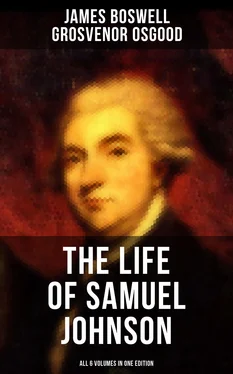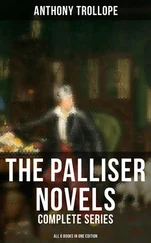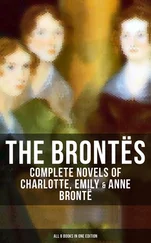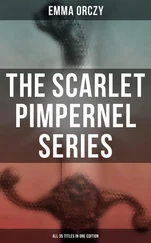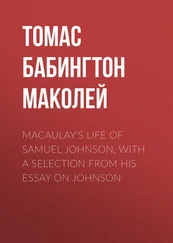[1074] Johnson was intimate with Lord Southwell, ante , p. 243. It seems unlikely that Baretti merely conducted Mr. Southwell from Turin to Venice; yet there is not a line in his Journey to show that any Englishman accompanied him from London to Turin.
[1075] See ante , p. 350, note.
[1076] The first of these annual exhibitions was opened on April 21, 1760, at the Room of the Society of Arts, in the Strand. ‘As a consequence of their success, grew the incorporation of a Society of Artists in 1765, by seccession from which finally was constituted the Royal Academy [In Dec. 1768].’ Taylor’s Reynolds , i. 179. For the third exhibition Johnson wrote the Preface to the catalogue. In this, speaking for the Committee of the Artists he says:—‘The purpose of this Exhibition is not to enrich the artist, but to advance the art; the eminent are not flattered with preference, nor the obscure insulted with contempt; whoever hopes to deserve public favour is here invited to display his merit.’ Northcote’s Reynolds , i. 101.
[1077] Hawkins ( Life , p. 318) says that Johnson told him ‘that in his whole life he was never capable of discerning the least resemblance of any kind between a picture and the subject it was intended to represent.’ This, however must have been an exaggeration on the part either of Hawkins or Johnson. His general ignorance of art is shown by Mrs. Piozzi ( Anec ., p. 98):—‘Sir Joshua Reynolds mentioned some picture as excellent. “It has often grieved me, sir,” said Mr. Johnson, “to see so much mind as the science of painting requires, laid out upon such perishable materials: why do not you oftener make use of copper? I could wish your superiority in the art you profess to be preserved in stuff more durable than canvas.” Sir Joshua urged the difficulty of procuring a plate large enough for historical subjects. “What foppish obstacles are these!” exclaims on a sudden Dr. Johnson. “Here is Thrale has a thousand tun of copper; you may paint it all round if you will, I suppose; it will serve him to brew in afterwards. Will it not, Sir?” to my husband who sat by. Indeed his utter scorn of painting was such, that I have heard him say, that he should sit very quietly in a room hung round with the works of the greatest masters, and never feel the slightest disposition to turn them, if their backs were outermost, unless it might be for the sake of telling Sir Joshua that he had turned them.’ Such a remark of Johnson’s must not, however, be taken too strictly. He often spoke at random, often with exaggeration. ‘There is in many minds a kind of vanity exerted to the disadvantage of themselves.’ This reflection of his is the opening sentence to the number of the Idler (No. 45) in which he thus writes about portrait-painting:—‘Genius is chiefly exerted in historical pictures; and the art of the painter of portraits is often lost in the obscurity of his subject. But it is in painting as in life; what is greatest is not always best. I should grieve to see Reynolds transfer to heroes and to goddesses, to empty splendour and to airy fiction, that art which is now employed in diffusing friendship, in reviving tenderness, in quickening the affections of the absent, and continuing the presence of the dead.’ It is recorded in Johnson’s Works , (1787) xi. 208, that ‘Johnson, talking with some persons about allegorical painting said, “I had rather see the portrait of a dog that I know than all the allegorical paintings they can show me in the world.”’ He bought prints of Burke, Dyer, and Goldsmith—‘Good impressions’ he said to hang in a little room that he was fitting up with prints. Croker’s Boswell , p. 639. Among his effects that were sold after his death were ‘sixty-one portraits framed and glazed,’ post , under Dec. 9, 1784. When he was at Paris, and saw the picture-gallery at the Palais Royal, he entered in his Diary:—‘I thought the pictures of Raphael fine;’ post , Oct. 16, 1775. The philosopher Hume was more insensible even than Johnson. Dr. J.H. Burton says:—‘It does not appear from any incident in his life, or allusions in his letters, which I can remember, that he had ever really admired a picture or a statue.’ Life of me , ii. 134.
[1078] By Colman—‘There is nothing else new,’ wrote Horace Walpole on March 7, 1761 ( Letters, in. 382), ‘but a very indifferent play, called The Jealous Wife , so well acted as to have succeeded greatly.’
[1079] In Chap. 47 of Rasselas Johnson had lately considered monastic life. Imlac says of the monks:—‘Their time is regularly distributed; one duty succeeds another, so that they are not left open to the distraction of unguided choice, nor lost in the shades of listless inactivity…. He that lives well in the world is better than he that lives well in a monastery. But perhaps every one is not able to stem the temptations of publick life; and, if he cannot conquer, he may properly retreat.’ See also post , March 15, 1776, and Boswell’s Hebrides , Aug. 19, 1773.
[1080] Baretti, in the preface to his Journey (p. vi.), says that the method of the book was due to Dr. Johnson. ‘It was he that exhorted me to write daily, and with all possible minuteness; it was he that pointed out the topics which would most interest and most delight in a future publication.’
[1081] He advised Boswell to go to Spain. Post , June 25 and July 26, 1763.
[1082] Dr. Percy records that ‘the first visit Goldsmith ever received from Johnson was on May 31, 1761, [ten days before this letter was written] when he gave an invitation to him, and much other company, many of them literary men, to a supper in his lodgings in Wine Office Court, Fleet Street. Percy being intimate with Johnson, was desired to call upon him and take him with him. As they went together the former was much struck with the studied neatness of Johnson’s dress. He had on a new suit of clothes, a new wig nicely powdered, and everything about him so perfectly dissimilar from his usual appearance that his companion could not help inquiring the cause of this singular transformation. “Why, Sir,” said Johnson, “I hear that Goldsmith, who is a very great sloven, justifies his disregard of cleanliness and decency by quoting my practice, and I am desirous this night to show him a better example.”’ Goldsmith’s Misc. Works , i. 62.
[1083] Judges , v. 20.
[1084] Psalms , xix. 2.
[1085] Psalms , civ. 19.
[1086] Boswell is ten years out in his date. This work was published in 1752. The review of it in the Gent. Mag . for that year, p. 146, was, I believe, by Johnson.
[1087] He accompanied Lord Macartney on his embassy to China in 1792. In 1797 he published his Account of the Embassy .
[1088] It was taken in 1759, and restored to France in 1763. Penny Cyclo . xi. 463.
[1089] W. S. Landor ( Works , ed. 1876, v. 99) says:—‘Extraordinary as were Johnson’s intellectual powers, he knew about as much of poetry as of geography. In one of his letters he talks of Guadaloupe as being in another hemisphere. Speaking of that island, his very words are these: “Whether you return hither or stay in another hemisphere.”’ Guadaloupe, being in the West Indies, is in another hemisphere.
[1090] See post , April 12, 1776.
[1091] ‘It is necessary to hope, though hope should always be deluded; for hope itself is happiness, and its frustrations, however frequent, are less dreadful than its extinction.’ The Idler , No. 58. See also post , under March 30, 1783, where he ranks the situation of the Prince of Wales as the happiest in the kingdom, partly on account of the enjoyment of hope.
Читать дальше
